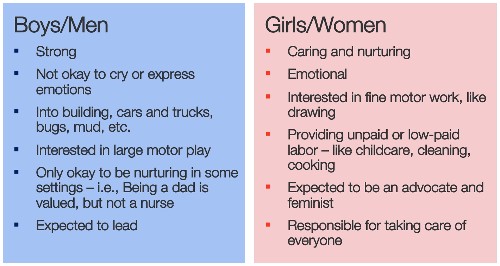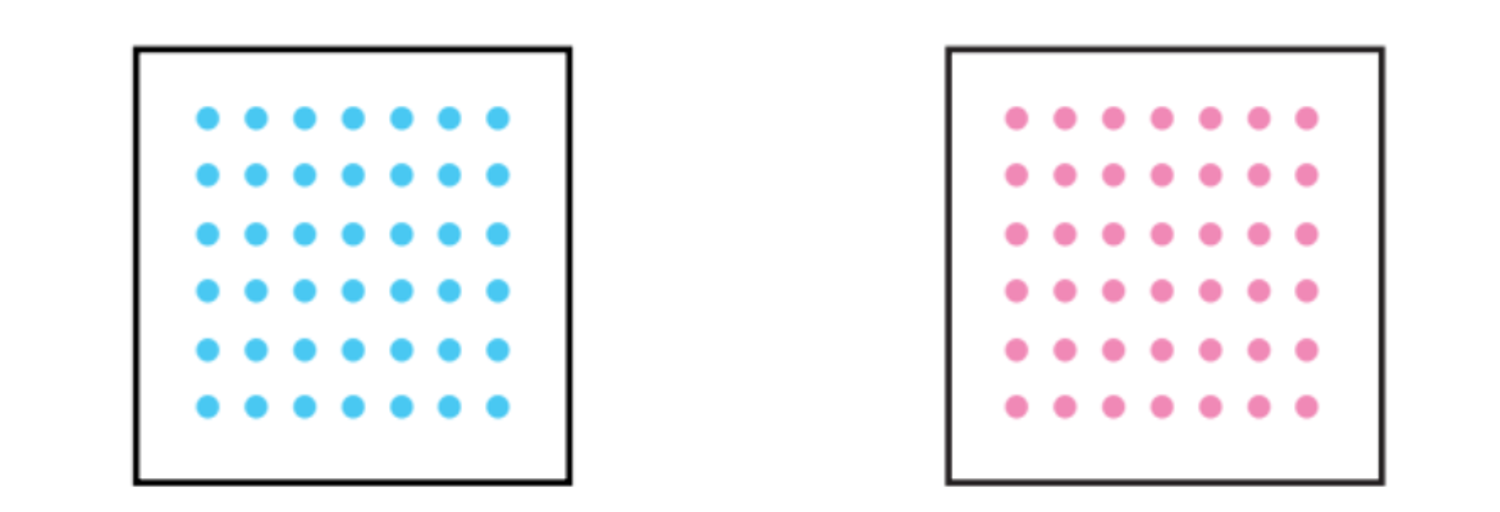Question
What are messages we often receive about gender as we grow up?
Answer
Figure 1 shows a visual representation of what we are going to be talking about as the gender binary. This is the dominant way of understanding gender in not only our US context but in many countries around the world. It is by no means the only way of understanding gender, but we want to start here because it's what most of us grew up with, it's what most of us are familiar with, and we want to make it visible because we're going to talk about it and some of the limitations.

Figure 1. Common messages received about gender.
In the gender binary, there are two boxes that people can fit in. You are basically assigned to that box based on a quick assessment at birth of the physical characteristics of your genitalia. You're either assigned to the boys' side or the girls' side, but a lot of things go along with which box you were assigned to. There are messages and norms about how you should dress, the kinds of interests you should have, as you grow up the kinds of jobs you should have, your romantic partners, and other norms, constraints, and expectations. Let's look at some of these.
We've asked people, "What are the messages that boys receive from the earliest ages about what it means to be a boy and what it means to be a man?" Some of the responses are in the blue box on the left in figure 1. These are things that people in our audiences all across the US have shared with us. Boys are supposed to be strong and it's not okay to cry or express emotions. They're into building, cars, trucks, bugs, and mud, and they're interested in large motor play like active play. Many people say that it's only okay to be nurturing in some settings. Being a dad is valued, but not being a dad who's too close and physical, and definitely not somebody in a caring profession, like an early educator or a nurse. Those are messages that would not fit in that box. You're expected to be strong, assertive, lead, have all the answers, be out front, and be comfortable with power.
In contrast to that, the right side of figure 1 in the pink box lists messages girls receive from the earliest age. Because of the box that they're assigned to, girls are supposed to be naturally caring, nurturing, and emotional. They're allowed to cry. They should be more interested in fine motor work, like drawing, sewing, and arts and crafts. They should naturally be called to do unpaid or low-paid labor, like childcare, cleaning, cooking, and teaching. They are expected to be an advocate, and in some circles, a feminist. They should be responsible for caring for others, and in many cases, invisiblizing the care to themselves.
Some of you might be thinking, "This makes sense to me. These messages are messages I've grown up with." Thinking about the gender binary, do you see how there are these boxes and no flow between the two? There's no flexibility. Children, youth, and adults who describe themselves as gender-expansive, non-binary, or transgender definitely don't fit into this gender binary. These are colleagues, friends, and children of ours who don't see themselves. It's not welcoming. It doesn't reflect them, but even if you do see yourself here, we believe and we ask you to think about the fact that there's no flexibility. We believe that there are probably times all throughout your life that you didn't neatly fit or you didn't neatly identify with some of the messages that you were forced to identify with being in your box. We are here to say that the gender binary is limiting for all people, including children and adults.

Figure 2. Stereotypes and social boxes.
Look at figure 2 and think about the expectations of the gender box that you're in and the way it has limited you. Think back and imagine a time when you were told you couldn't do something or shouldn't do something because that's not the way that girls should behave or women should behave or boys should behave or men should behave. There are stereotypes and limitations that harm and hold all of us back because they are so rigid and inflexible and don't account for what we know is true on all of this Earth, in all of humanity, and that is the normalcy of variation. Human variation and human diversity are the norms and how we all are. This doesn't account for that. We are here to help you think about other ways that we can consider gender, other ways that are more welcoming, more inclusive, more equitable and support all children and all adults' gender health.
This Ask the Expert is an edited excerpt from the course, Supporting Gender Diversity in Early Childhood, presented by Flynn, N. and Nicholson, J.

